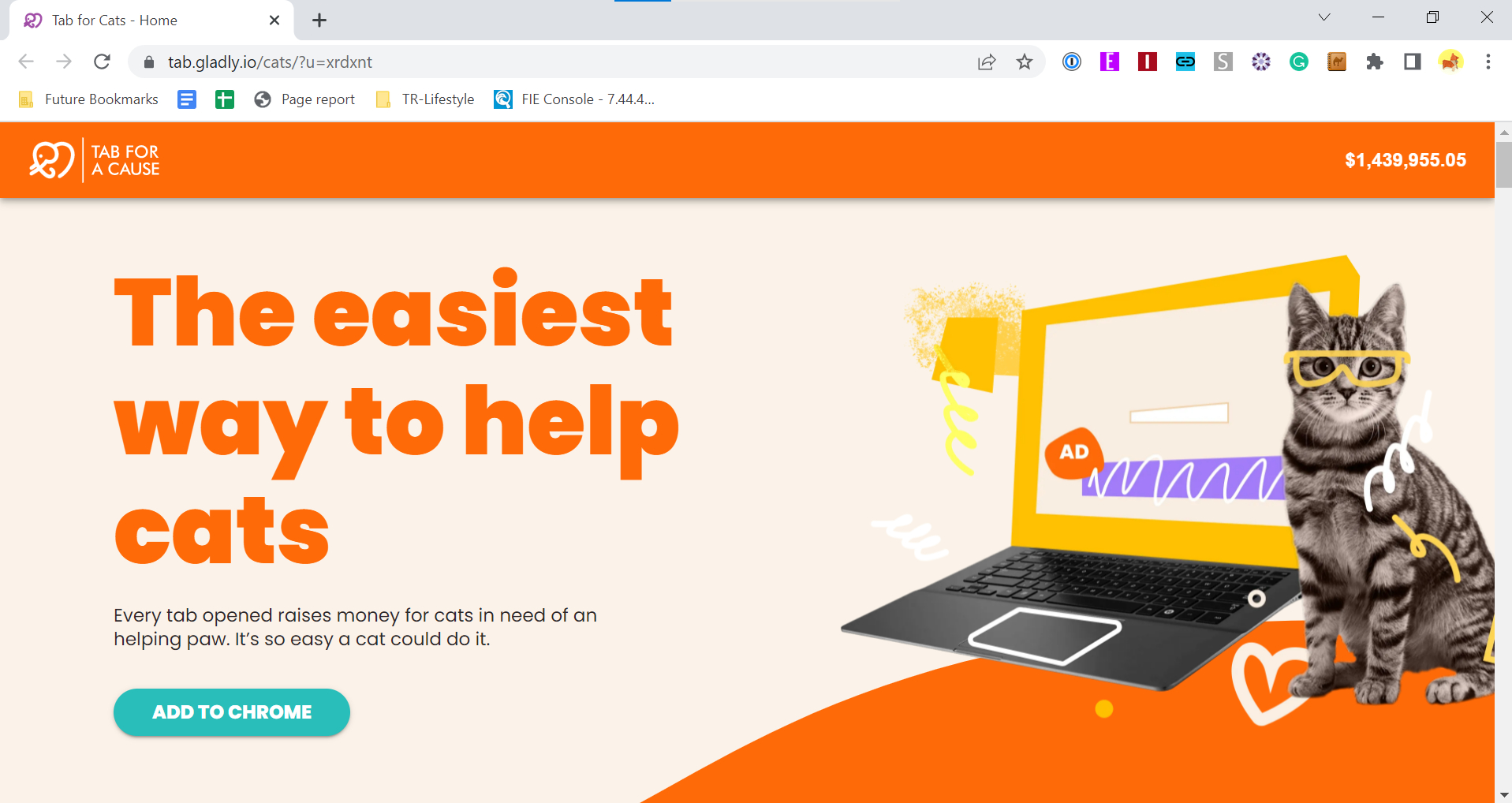
How many tabs do you have open right now? For me, it’s 78, and I am not here to pretend that is a healthy or manageable number.
It is, however, a potentially profitable one - especially if you have the Tab for a Cause browser extension downloaded, which turns your new tab pages into a charity fundraising opportunity.
On the surface, the idea is simple - use this plugin to augment your new tabs so that instead of a blank page or home screen, you’re shown a simple page with a search bar and a few banner advertisements. Once you’ve registered, you can select - and easily change - which causes you want your tabs to support.
We spoke with CEO and co-founder, Alex Groth about Tab for a Cause’s journey and mission, and to find out the role businesses like his play in the future of activism.
With an estimated 10-20 million tabs opened by Tab for a Cause users per month, it makes sense that the startup has been able to raise an impressive $1.4m for charity as of writing.
The company claims that 30% of revenue goes to charity, which the team claimed in a Reddit comment is actually a significantly higher bar than companies with similar models. Those broadcasting lofty claims of donating 100% of profits can actually be highly misleading, ensuring donatable profits are minimal through clever business and accounting tactics.
Like many new ideas, Tab for a Cause had humble beginnings. Kevin Jennison, Groth’s co-founder and CTO, had been making YouTube videos while at college, and upon seeing the platform’s monetization opportunities, the pair pondered the potential of a platform where ad revenue could be given to charity.
Sign up for breaking news, reviews, opinion, top tech deals, and more.
A friend pointed out that when they were opening tabs, it was just a blank web page that had the potential to display advertising - and so began the early days of Tab for a Cause.

From passion project to business
Being students, however, meant neither Jennison nor Groth had experience in the not-for-profit space, and what started as a fun project at college quickly became something bigger.
“We had volunteered here and there, so we had some kind of tangential experience, but we hadn’t done anything like this. Once we started going it was more about figuring out how to turn it into a real business and make it grow.
“When we first started out, we thought ‘Of course, everyone’s gonna use this, and we’re going to raise millions of dollars!’ but realistically, that’s not how it goes. But to see it now where we’re nearly at $1.5m just from opening some tabs? We’re pretty proud of that.”
Now, Tab for a Cause’s main goal is to create a platform that is as low-maintenance as possible for charities and gives young people wanting to contribute an opportunity at a stage in their life where they may not be financially capable, says Groth.
With its young user base and low-effort nature, some would be remiss to brand Tab for a Cause as casual slacktivism - a concern that Groth himself often considers: “If we give people a really easy and free way to do something, are they going to do that instead of direct donations or volunteering?”
However, he says from what the team sees in its user base, the answer is no. “We really serve a gateway into philanthropy - we tend to get people when they don't have money or time, or just want a first easy step.”
A great example is fundraising for the war in Ukraine - when people learned about the war and wanted to do something immediately, Tab for a Cause was there as an easy, quick start.
Try Tab for Ukraine pic.twitter.com/szjRYohV5aMarch 7, 2022
“It's important for people to understand that it isn't an either-or situation. Ultimately, we're going to build that relationship over time. So we're going to show you what's happening with nonprofits, and how they're supporting the cause. We see people then go on to donate directly to these nonprofits, and even apply for jobs at nonprofits.”
Its community of users has played a huge role in the development of Tab for a Cause over the past 10 years, too. “Whenever we’re thinking about major decisions, we try to survey our users to get some feedback,” Groth explains. “Thanks to the internet, we get constant feedback through comments, emails and socials, so we have this really steady stream of features that people want, or what people didn’t agree with.”
A large component of this audience engagement is around the causes Tab for a Cause partners with. “Anytime there’s a new cause that we bring on board, it’s usually because we got a number of emails about why people want to support it.”
However, it’s not always been smooth sailing with its community. Well-meaning members, for instance, have used bots to try and artificially boost fundraising efforts.
“As with everything on the internet, people will take it to the extreme as soon as they possibly can,” says Groth, “We've taken steps to protect the advertising networks from fraudulent traffic, but for the most part, we see it as a good thing - people are very enthusiastic, they want to do what they can.
“A lot of people are tech-first people, and so they think of technical solutions to maximize their impact. We generally try to reach out to them and say, ‘Hey, here are some ways where you can actually have an impact.’ We’re trying to give them outlets that are a little more productive.”
The road to $1.5m

Before partnering with a new nonprofit, the Tab for a Cause team tries to get a good understanding of what their impact metrics are, and then get monthly updates on what the results are, which are then shared on social media.
Groth says: “We try to connect people with that on-the-ground impact number, and we're going to be doing more of that. For example, in some of our annual reports we'll share results like ‘Tabbers have raised enough to plant 300,000 trees this month.’”
Despite the small amount of money raised by each tab, Groth reiterates just how impactful Tab for a Cause can be over time. Data is effectively a new form of currency, and while some may opt to obscure their data while surfing the web, Tab for a Cause presents an opportunity to at least have it do some good.
Tab for a Cause follows the current online advertising market trends, using some of the biggest ad networks from Google, Amazon and Xendr (formally known as AppNexus) to connect advertisers with its tabbers, and outside of this, Groth says the company doesn’t ask for any data, barring an email address when you register, which is not passed on to any third-parties.
I first reached out to Groth and his team after being served a Facebook ad for a cause-focused tab, Tab for Cats, which focuses on rehabilitating shelter cats - right up my alley. Moving forwards Groth sees potential in tabs like these that focus on specific causes, rather than the more general extension that allows you to chop and change.

Groth says thus far, these specific tabs have been really successful, however, it’s still an idea in beta while they iron out the kinks. Currently, you can’t switch between these cause-specific tabs and the general Tab for a Cause extension easily, but Groth hopes to fix this in the future.
“You might be a cat person today, but in a couple of days, you’ll want to support reproductive health, black equity, or switch around those different verticals.”
In the long-term, Groth says that he wants to detach Tab for a Cause from its reliance on ad networks and go direct with advertisers, based on the content shared through the extension, and remove the dependency on user data altogether by focusing on targeted tabs like Tab for Cats.
Tough on tabs?

While there’s plenty of room to grow still in the desktop tabs environment, there are still challenges - and opportunities - ahead.
For example, the rise of mobile usage for web browsing makes for a not-too-distant hurdle to overcome. Groth says that it could be tough on tabs, as the way people use them on mobile tends to be a little bit different than how they do on laptops, and mobile browsers don’t allow for extensions to work in the same way.
Groth, however, has a plan. “The core of what we're doing is taking online actions that already exist and harnessing them for charity. There are a lot of those on mobile that we can piggyback off of, so we’re definitely working on figuring that out quickly.”
Still, there remains to be plenty of opportunity in environments where desktops are used regularly. Groth says schools and businesses, for instance, are an area of interest for Tab for a Cause, where teams could unite around certain impact goals.
“We've started to have companies reach out saying they are interested in sort of getting installed for everyone on their system, and then ideally tracking all their impact together. So it can be ... a community-building exercise and maybe piggyback off of other fundraising efforts. So we're excited for that - but it's probably a little bit early.”
Then there’s expanding beyond the US; while some charities have global coverage, many smaller causes and charities working with Tab for a Cause are US-centric, but Groth sees this changing as part of future expansion.
In a sea of Instagram slacktivism and at a point in time where money is tight and there is a lot of good that needs to be done in the world, companies like Tab for a Cause present socially-engaged younger people with an opportunity to contribute. The possibilities with ideas like this are endless, and we can’t wait to see how companies like Tab for a Cause and Ecosia take digital fundraising next.

Josephine Watson is TechRadar's Managing Editor - Lifestyle. Josephine is an award-winning journalist (PPA 30 under 30 2024), having previously written on a variety of topics, from pop culture to gaming and even the energy industry, joining TechRadar to support general site management. She is a smart home nerd, champion of TechRadar's sustainability efforts as well and an advocate for internet safety and education. She has used her position to fight for progressive approaches towards diversity and inclusion, mental health, and neurodiversity in corporate settings. Generally, you'll find her fiddling with her smart home setup, watching Disney movies, playing on her Switch, or rewatching the extended edition of Lord of the Rings... again.